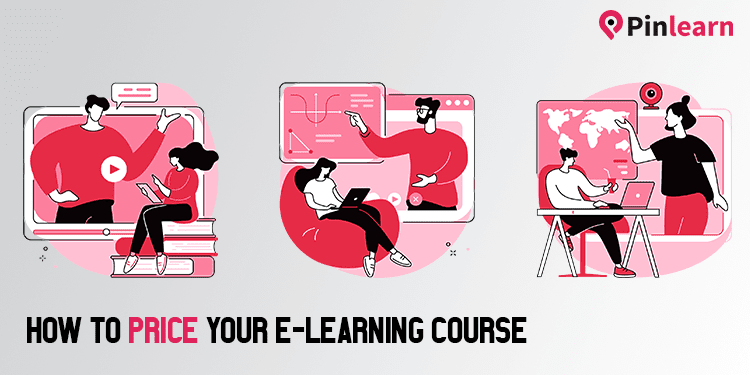How to Price an Online Course – A Guide to Pricing Strategy
After creating an online course, one of the challenges creators face is how to set a befitting price for it. This is normal because you do not want people to take your course lightly.
Underpricing your knowledge reduces the way people perceive it. But you do not want to overprice yourself out of the market either.
There is no one-size-fits-all approach to pricing your online course because audiences differ. However, at the end of this post, you should have figured out how to price your online course.
Factors to Consider When Pricing Your Course
When placing a price tag on your course, consider your customers, your competitors, and the cost of production.
A combination of these three factors will help you maximize profit and satisfy your customers.
How Customers Perceive Your Course
The amount of money a customer pays for your product or service reflects its value. But it is worth mentioning that customers perceive value in different ways.
To some people, the buying experience is what holds the most value. Others value the packaging or the solution that the product or service will provide.
Because value is relative, you can’t base your pricing method only on value.
One person may be willing to pay higher for your course, while another may see it as a waste of money. Customers differ.
People tend to pay more when the course is technical, has high-quality content, and offers extra support and bonuses.
In fact, they will be highly motivated to finish the course so they can get the exact results that the course promises.
When these participants become beneficiaries, they won’t hesitate to leave you positive reviews. And high ratings from previous customers can dramatically increase the value of your course.
Take a Peep at What Your Competitors Are Offering
In business, you’re allowed to snoop a little at your competitors. This will give you an idea of how much they charge for different course categories.
In addition, you should find out the type of customers your competitors are selling to, including any extra services they offer for such prices.
Doing this regularly is essential because the market forces (demand and supply) can change at any time. And you do not want to arrive late to the party.
For instance, if the course you offer has become a best-seller, the price will push up. So, increasing your price can fetch you more profits.
However, you don’t need to hang onto a price because that’s what others are charging. Make sure it reflects the true value of the knowledge you’re offering.
Consider Your Cost of Production
Your production cost is imperative in fixing a selling price. Otherwise, you will run at a loss.
So, in this case, you should consider the following:
- The time spent on putting the course together
- The cost of your materials and/or equipment
- The lecturer’s salary
- The cost of using the premises where you’re recording the course from
Additionally, you must consider the amount of profit you intend to make. Considering both direct and indirect costs ensure that you do not underprice your course.
How to Price Your Course
When considering how much to charge for an online course, it’s natural to consider what you spent in terms of time, money, and effort to develop the course.
In this section, I will discuss an online course pricing strategy that has been working for both B2B and B2C companies.
This strategy is known as the tiered system of pricing. You may have come across tiered pricing but haven’t considered it for your e-learning course.
Not to worry, I’ll show you how it works so you can start utilizing it from today.
What is Tiered Pricing?
Tiered pricing is when a seller offers the same product or service for different prices. The difference is the benefits or features that each price level offers.
This model allows customers to choose the category they can afford in the meantime. Over time, the benefits of the upper tiers will motivate them to purchase a product/service that offers more benefits or features.
In e-learning courses, there are four tiers of pricing:
- Free
- Paid
- Subscription
- Premium
Let’s see how to price e-learning courses using the tiered pricing model.
The Free Course Tier
This is usually the point of introduction; a customer’s first encounter with your offering. New tutors use this strategy to attract customers with the hope of a long-term engagement.
Established course creators, on the other hand, use free courses to generate quality leads. Oftentimes, it’s a bonus for new customers to move to the next tier and become paying customers.
Note that free does not connote cheap. So, before you release a free course, make sure there is a rewarding strategy behind it.
The Paid Course Tier
Paid courses are common. In this tier, customers make a one-time payment.
The prices are mostly low to accommodate the needs of customers who are not sure whether they want to invest a lot of money in your course content yet.
Now, you do not want to reduce the quality of your course because of the low price. What you should do instead is offer the essentials or basics at an affordable price.
The Subscription Course Tier
In the subscription model, you will offer your course on a recurring basis. As a result, your customers can pay for new content weekly, monthly, or yearly.
This method is common with membership sites where members pay to be a part of a network or closed group.
The Premium Course Tier
When it comes to premium, feel free to charge more. Typically, premium courses sum up the price for about six (6) months or 1 year so customers can pay at once but with a little discount.
A premium tier pricing model is suitable for intensive courses or those that lead to getting a certification.
How to Validate Your Price with Your Target Audience
The best way to find out how much your customers are willing to pay is to ask them. This doesn’t mean you should ask them directly.
They will definitely choose a low price and you don’t want to be out of business by being a people-pleaser.
Therefore, a sure method of validating your price is by creating a survey.
Below are important points to infuse in the survey.
- Start by finding out what you should do to serve them better.
- Ask general questions on customer satisfaction.
- Ask questions that are related to pricing.
Price-related questions should include the following:
Whether they have considered purchasing alternative courses or not ?
If they didn’t, then you should consider increasing your price. But if they did, then you should match the character traits of the customers that are price sensitive. This will help you to do proper market segmentation.
Whether your price is too high or too low?
You shouldn’t spend much time on this interview. Just get a simple yes or no answer and move on. But if the customer is willing to give an elaborate response, listen and make notes.
Whether you should add new content or features and will they be willing to pay a premium?
Most times, customers offer valuable insights that result in new offerings. It is also important to find out whether they will be happy to pay more for the additional feature.
If you haven’t launched your course yet, release a pre-launch and see how your target audience will respond to the price.
Bear in mind that course pricing is not static. Even after launching the full course, keep testing it.
Should You Charge a Low Price or a Premium Price?
When it comes to pricing an e-learning course, you may want to charge a low price because the market seems saturated. Of course, there are lots of free courses on the internet.
But here’s the thing: your price reflects the value of the content.
In fact, in the psychology of buying, people associate high prices with quality. So, if you charge lower prices, most people will think you’re offering them thrash.
Additionally, charging a premium price sets you apart from the competition. It’s a way to consciously create a niche for yourself in a highly competitive market.
Because many people sell courses online, they set their prices to be a bit low so they can sell to many customers.
Let’s consider this scenario:
A course is sold for $50 to 100 people. The seller has earned $5000.
Another course is sold for $100 to 50 people. The seller has also earned $5000.
Both sellers earned the same amount using different pricing strategies. The first seller had to reach out to more people while the second seller only needed half of that number to earn the same amount.
It takes a lot of effort to get more people to buy your product or service. However, offering a premium allows you to offer different plans or packages that can accommodate different categories of buyers.
The Bottom Line
If you’ve read up to this point, congratulations!
You’re now more knowledgeable on how to price a training course.
If you’re still not sure whether your price is too high or too low, just estimate how much it will cost to develop an online course, set a profit margin, and you’re good to go.
The truth is that irrespective of what you charge, your course will still be expensive for someone.
Choose a price, then use your customers to validate it. Remember that pricing is not a once and forget activity. You can change it until you find one that your customers are willing to pay.





